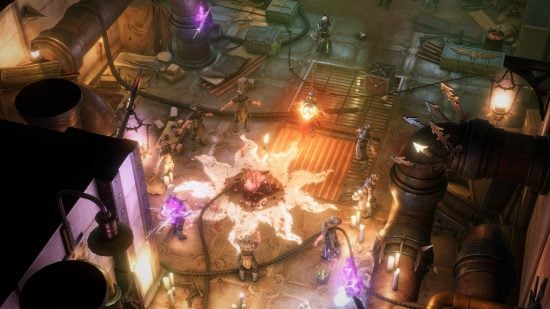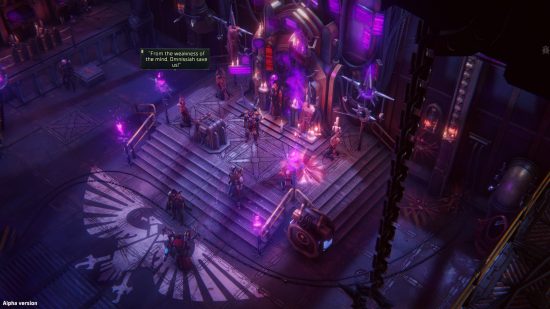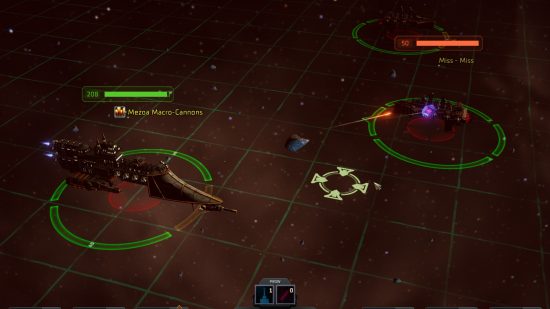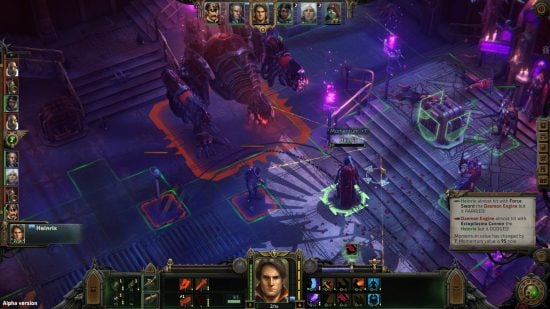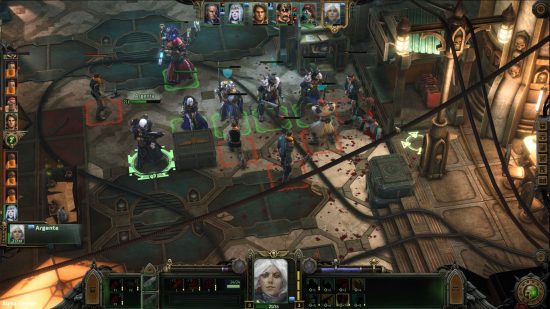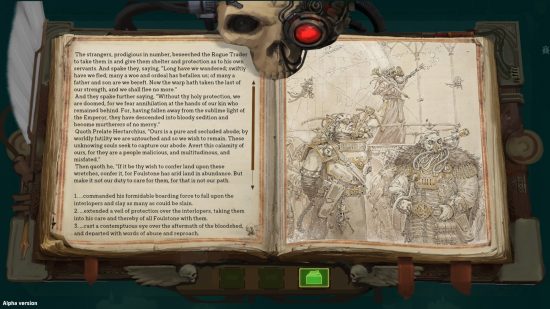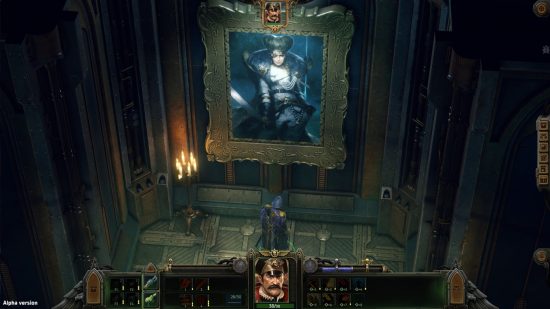I’ve had my clammy hands on the alpha build of Warhammer 40k Rogue Trader over the weekend, sneaking in 15 hours with the new CRPG from Owlcat Games. Zealous fans who sprang the cash for the luxurious Developer Digital edition or Collector’s edition of the game will be able to try it out for themselves on December 7, and might be wondering if it was a sound investment. Good news, folks – Rogue Trader looks like it’s going to rock.
Developers Owlcat Games have got to nail two things to make Rogue Trader a success: it’s got to work as a CRPG, and it’s got to feel like Warhammer 40k. Sounds obvious, but those are two objectives that are harder to reconcile than you think. The setting’s motto, “In the grim darkness of the 41st millennium, there is only war!” is badass, but it limits the kinds of stories you can tell. Warhammer 40k Darktide, Mechanicus and Chaos Gate are all fantastic 40k games with fun characters and strong writing, but their narrative is linear and not really the point of those games.
Uniquely among the Warhammer 40k factions, particularly the hidebound and belligerent human Imperium, Rogue Traders have both freedom and power. Their ancient Warrant of trade, signed by the high Lords of Terra – or in the case of some ancient bloodlines, the Emperor of mankind himself – grants them the freedom and the duty to push back the borders of the Imperium, striking into unclaimed territory in pursuit of profit and glory. They’re powerful dynasts, whose vast wealth is enmeshed in the politics of the Imperium, but also frontier-striding explorers, granted a rare degree of autonomy in their dealings. Rogue Traders are Imperial servants, but they operate outside the rules.
So, Francis Drake in space, complete with dynastic politics and social intrigue – it’s a strong starting point for any RPG. In the alpha you’ll create a character by choosing the key events in your character’s life – to be recorded in a dossier evaluating them as a potential heir to the throne of the von Valancius Rogue Trader dynasty.
From there, you’ll join the story in media res with chapter two, after Rogue Trader Theodora Von Valancius has been murdered and your character elevated to the throne of her voidship. This skips and spoils a substantial chunk of the plot, but does mean that alpha participants get to play with all the game’s systems. First, though, you’ll pass through Footfall.
Footfall is a space station built on a cluster of asteroids, covered in statues and fragments of cathedral architecture. It looks like a classic piece of Warhammer 40k gothic nonsense, but there’s a treasure hunt side-quest to be found that unveils an interesting and rational explanation for the station’s absurd architecture. It’s a small thing, but a good example of Owlcat Games really understanding the setting they’re working with.
Graphically, Rogue Trader is serviceable, but the art design does a good job evoking the baroque grime of the 41st millennium. The slums of Footfall’s shadow quarter mix ruins, densely-packed industrial buildings, and glowering propaganda posters exhorting the populace to devotion to the Emperor. Industrial machines are coated in drippy wax candles, while computer terminals have flickering, green-text computer screens. There’s a lot of grey, but later, you’ll explore the lush surface of paradise worlds – the contrast is startling.
After the events of Chapter One, no-one is expecting your character to show up as the head of the von Valancius dynasty. You can enter the starport formally, announcing your title and throwing your weight around, or go incognito, enjoying anonymity. Even if this is just an aesthetic choice, it’s a well-realised one that helps emphasise your character’s station and status. I went in loud, which saw me accompanied by a hovering servo-skull that loudly pronounced my rank and title, crowds of serfs and voidworkers cow-towing before me. As they should.
Unfortunately, my welcome party was crashed by some unwelcome guests. Within seconds of arriving I was into the alpha’s first combat, as dozens of anarchists rained fire onto my entourage. The alpha gives you a full party of level 15 characters with toolbars bustling with abilities, so it was a confusing experience for me. More thoroughly prodding the game shows that it’s also not at all balanced yet. It is, however, bloody good fun.
Combat is turn-based and uses a grid for movement, as well as those friendly half and full cover icons you’ll be familiar with from games like XCOM and Chaos Gate. Characters have separate pools of movement and action points, and are usually limited to one attack action per round, though they’ll probably have a stash of powers and more than one weapon set to play with. Throughout the battle your party and your enemies will push and pull over “momentum”, building it up when you attack and losing it when you suffer damage. When the momentum’s high enough your party can use powerful once-per-battle Heroic Acts, or Desperate Measures if the momentum has swung far enough against you.
The numbers haven’t been tweaked to make combat balanced, but it certainly feels right. The game throws hordes of enemies at you and tracks every bullet separately: friendly fire is very much allowed, and combats can become a chaotic exchange of ordnance. Enemies explode into showers of gibs, get thrown around by explosions or knocked back by hammer blows. Weapon effects are just fantastic – hours in, I still hoot like a gibbon whenever I discharge Interrogator Heinrix’s inferno pistol, engulfing a crowd of heretics in a roaring, apocalyptic fireball. The boltgun sounds like the wrath of God.
Combat encounters are well-paced, spread at satisfying intervals throughout the narrative, and each of them takes place in an interesting environment. Sadly, the camera doesn’t always frame them to best advantage. Some of the issues are probably because the game is still in alpha: the camera doesn’t know whether it should show the attacker or the target when a ranged attack crosses more than one screen. But troubles with manoeuvring around scenery seem a little harder to resolve: Footfall has a lot of dense, tall buildings, particularly in the slums, and in some locations there’s just no good place to put the camera.
Your party are visiting Footfall for ship repairs, and also to get acquainted with all the major trading partners in the Koronus expanse: the techpriests of a Martian explorator fleet, holy pilgrims of St. Drusus, the Kasballica organised crime syndicate, and pirates. Trading is one system where mechanics gel with narrative. After slaughtering the two dozen bandits who assailed me in the Footfall docks, I began looting their corpses, and noticed the option to ‘Pack as cargo’. Loot, whether it’s a weapon you can equip or one of the Imperium’s trade goods – holy scriptures, drinkable engine coolant – can be bundled up into cargo stacks, which you can then give to one of the factions to strengthen your trade alliance.
Building up your trade relationship with a faction offers access to more items from the faction’s storefront. As a fabulously wealthy Rogue Trader you don’t pay for these with anything as crass as money: instead, you dip into the ‘Profit Factor’ of your empire, a regenerating resource that can increase or decrease based on your actions in the game. I hope there are narrative repercussions for building up one trade alliance and letting another wither.
As well as the main story, Footfall has a companion quest for Sister Argenta, one of the Sisters of Battle and a fanatical devotee of the cult of the Emperor, which you must complete to make her a permanent part of your retinue. The quest is straightforward but the writing in support of it does a great job adding nuance to her character. You learn why she feels such disquiet at arriving on Footfall. Argenta was tasked by her holy order to defend the reliquary of Saint Drusus, but her journey through the warp went astray in time. She arrived a century late, finding everyone who might have expected her dead, and a band of pilgrims guarding the reliquary, rendering her holy mission purposeless. It’s unexpectedly poignant, giving depth to a character who could easily be a one-dimensional, religious zealot.
Footfall is the jumping-off point from the wider Imperium of Man into the untamed Koronus Expanse, where warp storms have once again destroyed all safe routes between star systems. Once you’re finished with Footfall you’ll set off into the uncharted void and get down to some real Rogue Trading.
Your main quest involves reconnecting the primary worlds in your dynasty’s trade empire with the Imperium, but first you’ve got to find them. The star-chart is intimidatingly large and starts off totally blank – it’s up to you to discover new systems, and safe warp-routes to reach them. Those systems might contain pirates to fight, resources to exploit, derelict vessels or mysterious locations to explore, or text-based encounters ranging from exploring a dead city to reconciling settlers and monks to found a new colony. Mercifully, there is no minigame for scanning planets. These are all in a provisional state, but it’s clear that Owlcat Games is building on its experience with dynasty management in Pathfinder: Kingmaker.
Rogue Trader in its alpha state is a long way from completion, and it has plenty of bugs. Text blocks loading in Cyrillic rather than English is quite common, and I got into a hard-lock when a plot-critical questline got trapped in an unresolvable state. But as a CRPG it seems like a solid foundation, and as a piece of 40k worldbuilding it’s an achievement. As a lore-nerd, I could nitpick that the Techpriest Pasqal shouldn’t have a higher Lore (Warp) skill than the Navigator Cassia as a side effect of his high Intelligence score. I’d like to see more responsive dialogue with party members, mostly because they’re all extremely likeable, from the troubled psyker Idira to the bluff old seneschal Abalard. And of course the whole thing could collapse like a souffle before we get a finished build, but that’s a risk with every unreleased game.
You can get access to this build of the game on December 7 if you fork out for the Developer’s Digital edition or Collector’s edition of the game. There are three reasons to buy the alpha of Rogue Trader: you want the swag statuette that’s among the Warhammer 40k Rogue Trader Collector’s edition contents, you want to support the developers, or you want to learn what the alpha build of the CRPG looks like. There’s one, main reason that you shouldn’t: the game looks like it will be really, really good, and it should only get better from here.
